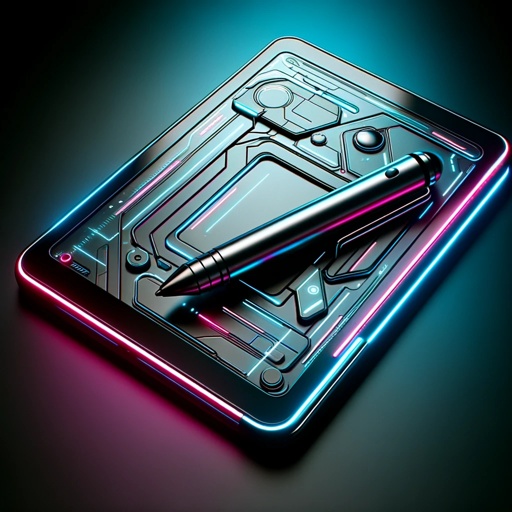3D Modeling for Product Design-advanced 3D modeling software.
AI-Powered 3D Modeling for Designers
Introduce 3D Modeling for Design. 🖥️
Upload image or file. 🖼️📁
Tell me about your capabilities. 📃
How to start with 3D modeling? 📚
Related Tools
Load More
3D CAD Pro🔍 : CATIA, Automation
CATIA V5 & 3DEXPERIENCE Specialist (https://twitter.com/ejlee0)

3D-Designer
Design and create custom 3D printables without a mechanical design software.

DesignGPT
DesignGPT is an AI product designer created by Innoverse, accelerating the evolution of design to intelligence.

STL File Creator + Researcher + Advanced Modeling
Simplifies 3D model creation with basic Python tools and precise research.

Product Design Pro
Expert in product design, offers tailored advice and detailed illustrations.提案したデザインのコンセプトをリアルなイラストで視覚化できます。日本語対応。(24/01/2024 UPDATE)

Concept Design
3D model concept image creator using DALL-E 3. Copyright (C) 2024, Sourceduty - All Rights Reserved.
20.0 / 5 (200 votes)
Introduction to 3D Modeling for Product Design
3D modeling for product design involves creating a digital representation of a product using specialized software. These digital models serve as a blueprint for manufacturing, allowing designers to visualize, test, and refine their ideas before physical production. The primary purpose of 3D modeling in product design is to enhance accuracy, streamline the development process, and facilitate collaboration among various stakeholders. For instance, a designer might create a 3D model of a new smartphone, allowing engineers to assess the design's feasibility, marketing teams to prepare promotional materials, and manufacturers to plan production processes.

Main Functions of 3D Modeling for Product Design
Concept Visualization
Example
Creating detailed 3D models of a new kitchen appliance to visualize its form and functionality.
Scenario
A design team can use 3D modeling to present a photorealistic rendering of a new blender to stakeholders, showcasing different color options and surface finishes before any physical prototype is made.
Prototyping and Testing
Example
Developing a 3D model of a medical device to simulate its usage and test for potential ergonomic issues.
Scenario
Engineers can use 3D modeling to create a virtual prototype of a new surgical tool, allowing for virtual simulations to test its usability and make adjustments before creating a physical prototype.
Manufacturing Preparation
Example
Designing a 3D model of an automotive part to plan its manufacturing process.
Scenario
Manufacturers can use 3D models to design molds and plan the machining process for a car engine component, ensuring precision and reducing material waste.
Ideal Users of 3D Modeling for Product Design Services
Industrial Designers
Industrial designers benefit from 3D modeling as it allows them to explore and iterate on product concepts quickly. They can create detailed and accurate representations of their designs, facilitating better communication with engineers and stakeholders, and speeding up the development process.
Engineers
Engineers use 3D modeling to ensure that product designs are functional and manufacturable. By creating and testing virtual prototypes, they can identify and solve potential issues early in the development process, saving time and resources during physical production.

Steps for Using 3D Modeling for Product Design
Step 1
Visit aichatonline.org for a free trial without login, also no need for ChatGPT Plus.
Step 2
Install and set up a 3D modeling software suitable for product design, such as Blender, SolidWorks, or Fusion 360.
Step 3
Familiarize yourself with the basic tools and interface of the software. Take advantage of tutorials and online resources.
Step 4
Begin your design by creating basic shapes and gradually adding details. Use reference images and sketches to guide your modeling process.
Step 5
Refine your model by adding textures, colors, and fine details. Perform simulations or renderings to visualize the final product.
Try other advanced and practical GPTs
Image Creator
AI-Powered Image Creation Tool

Brand Development Assistant
Empower Your Brand with AI Insights

Svelte Assistant
AI-powered tool for Svelte developers

Website Audit - interfas.ai
AI-Powered Website Optimization Tool

Sysadmin for Ubuntu 22.04
AI-driven support for Ubuntu management.

Consultor EFD Contribuições
AI-Powered EFD Contribuições Guidance.

Сора текст в видео
AI-powered video creation from text

Русский Редактор
AI-powered Russian Text Editing

Курсовая работа
AI-powered academic writing assistant.

热点新闻(Breaking News)
AI-Powered News at Your Fingertips

DMARCレポート分析 ver1
AI-powered DMARC Report Analyzer

Python engineer - To the point
AI-powered Python solutions on demand.

- Prototyping
- Visualization
- Simulation
- Animation
- Rendering
3D Modeling for Product Design Q&A
What software is recommended for 3D modeling in product design?
Popular software for 3D modeling in product design includes Blender, SolidWorks, Fusion 360, and Rhino. These tools offer a range of features suitable for both beginners and advanced users.
What are the common use cases of 3D modeling in product design?
Common use cases include prototyping, visualizing product concepts, testing design functionality, creating marketing materials, and generating detailed design specifications for manufacturing.
How can I improve my skills in 3D modeling for product design?
Practice regularly, follow tutorials, join online communities, participate in design challenges, and study real-world products to understand design principles and techniques.
What are the key benefits of using 3D modeling in product design?
Key benefits include the ability to visualize concepts, test and iterate designs, reduce prototyping costs, and improve communication with stakeholders through detailed models and renderings.
Can 3D modeling be used for both conceptual and detailed design?
Yes, 3D modeling is versatile and can be used for both conceptual designs, where the focus is on form and aesthetics, and detailed designs, where precise dimensions and specifications are critical.